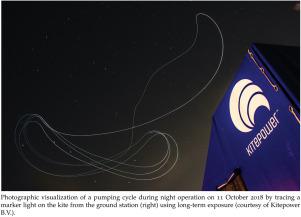Annual Reviews in Control ( IF 7.3 ) Pub Date : 2021-04-24 , DOI: 10.1016/j.arcontrol.2021.03.002 Chris Vermillion , Mitchell Cobb , Lorenzo Fagiano , Rachel Leuthold , Moritz Diehl , Roy S. Smith , Tony A. Wood , Sebastian Rapp , Roland Schmehl , David Olinger , Michael Demetriou

|
Airborne wind energy systems convert wind energy into electricity using tethered flying devices, typically flexible kites or aircraft. Replacing the tower and foundation of conventional wind turbines can substantially reduce the material use and, consequently, the cost of energy, while providing access to wind at higher altitudes. Because the flight operation of tethered devices can be adjusted to a varying wind resource, the energy availability increases in comparison to conventional wind turbines. Ultimately, this represents a rich topic for the study of real-time optimal control strategies that must function robustly in a spatiotemporally varying environment. With all of the opportunities that airborne wind energy systems bring, however, there are also a host of challenges, particularly those relating to robustness in extreme operating conditions and launching/landing the system (especially in the absence of wind). Thus, airborne wind energy systems can be viewed as a control system designer’s paradise or nightmare, depending on one’s perspective. This survey article explores insights from the development and experimental deployment of control systems for airborne wind energy platforms over approximately the past two decades, highlighting both the optimal control approaches that have been used to extract the maximal amount of power from tethered systems and the robust modal control approaches that have been used to achieve reliable launch, landing, and extreme wind operation. This survey will detail several of the many prototypes that have been deployed over the last decade and will discuss future directions of airborne wind energy technology as well as its nascent adoption in other domains, such as ocean energy.
中文翻译:

空中电力:来自机载风能系统二十年先进控制研究和实验飞行测试的见解
机载风能系统使用系留飞行装置(通常是灵活的风筝或飞机)将风能转化为电能。更换传统风力涡轮机的塔架和基础可以显着减少材料使用,从而降低能源成本,同时提供更高海拔的风能。由于系留设备的飞行操作可以根据不断变化的风力资源进行调整,因此与传统风力涡轮机相比,能源可用性有所增加。最终,这代表了研究实时最优控制策略的丰富主题,这些策略必须在时空变化的环境中稳健运行。然而,在机载风能系统带来的所有机遇的同时,也存在许多挑战,特别是那些与极端操作条件下的稳健性和发射/着陆系统(尤其是在没有风的情况下)有关的内容。因此,机载风能系统可视为控制系统设计师的天堂或噩梦,这取决于个人的观点。这篇调查文章探讨了大约在过去二十年中机载风能平台控制系统的开发和实验部署的见解,重点介绍了用于从系留系统中提取最大功率的最佳控制方法和稳健的模态用于实现可靠的发射、着陆和极端风力运行的控制方法。










































 京公网安备 11010802027423号
京公网安备 11010802027423号